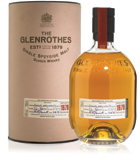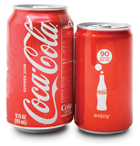Some companies instinctively know that good design makes good business sense, but most seem at a complete loss in how to determine the best, most consistent way of measuring it. Without quantifiable commercial measures, though, design will continue to be regarded with suspicion and seen as an expense rather than an investment, and the industry will not earn the recognition-and revenues-it truly deserves.
It is therefore imperative to clarify your business and commercial needs at the start of a design project, and to build these into your brief. There’s no benefit in being measured on something you cannot properly influence and no point investing in a project that you know will never deliver the targets you’ve identified.
It is also imperative to understand the impact the packaging discipline can have on those objectives. Consider how, in the packaging design industry, we are having a bit of an identity crisis. We have started to believe in the importance of what we do so much that we now proclaim to be able to do everything for a brand. We are trying to offer full-service communications: delivering the brand’s message and values, the product benefits and the improved consumer lifestyle-all by creatively using an inanimate 10-inch square canvas in a noisy, low-involvement environment with poor lighting.
It simply doesn’t hold up; packaging isn’t that powerful. Indeed, it has an extremely vital role to play, but it is not the only player. We must accept that packaging design is part of a bigger communications picture (TV, digital, sponsorship, direct marketing, viral, outdoor, public relations, etc.).
Packaging design’s role is primarily one of a brand identifier, the link and catalyst to all other learned brand associations (the red of the Coke can takes you to the world of Coca-Cola, immortalized by a century’s worth of communications). For new brands, packaging is a link to other learned symbolic associations (the childlike drawing on an Innocent package takes you to an untainted and honest world, something very powerful and inherently understood).
Of course these identifiers need to reflect and support all other brand communication, and not contradict it; and unless they have standout, and are recognised and remembered, they will have failed at their job and can have a devastating effect on sales-Tropicana’s 2009 redesign the case of all cases.
If you accept this as the role packaging design plays, i.e., as the link to brand meaning rather than brand meaning itself, it becomes much easier to specify the quantifiable commercial measures that packaging can be realistically graded on. Quantifiable targets also create a far more compelling business case to justify the need for a packaging design change.

The weight of a Glenrothes glass bottle conveys quality, and shows how looking, feeling and functioning best in class can justify a premium.
Measure A: Growth
Effective packaging design will have a direct impact on a brand’s growth, whether it is measured in volume or value of sales. As we all know, shoppers (consumers with a specific mindset) purchase irrationally, they do not weigh up the pros and cons of every pack they pick up off the shelf, assessing the cost-value ratio; they purchase instinctively, driven by emotions and their implicit associative memories. And they are susceptible to “rationally irrelevant” influences from their immediate environment.Packaging is just such an influence. The more the pack stands out and links to shoppers’ positive “learned associations,” it will either shake them out of their auto pilot mode or glue them to its track, vastly increasing the likelihood of being purchased. Of course, if the associations are negative or uninspiring it will be ignored…and it will be time for a total brand rethink.
There will be other influencing factors-price promotions, product sampling and point of sale materials-that will grab attention, attempting to disrupt or reinforce the shopper’s natural instinct. Therefore, when measuring the growth effect of the package design, these factors must be either removed (short timescale measuring) or accepted as a constant (long timescale measuring).
Measuring packaging-influenced brand growth must initially start with a set of controls, measures of “brand awareness,” “brand liking” and “sales value” that are considered over a fixed timescale. For established brands, we then take the bold step of associating all the brand awareness and liking to all other brand communications, omitting packaging design as an influence on these figures. This means that, when a pack design changes, we have our factoring figures (awareness and liking) and a sales base figure to measure against.
So, if a pack design change happens, with no changes to other communications activity, our factoring figures stay constant and we can associate any brand uplift to design. Or when the more likely scenario happens (a pack design changes amidst a change in communications activity), we use the new figures for awareness and liking, driven by this communications activity, as the new factors for calculating the direct effect of the packaging design on sales value. That is, if the awareness and liking figures have improved, the impact that packaging can rightly claim will be lower. Conversely, if they have diminished, the positive effect the packaging has made on sales will be enormous.
A brand’s awareness and liking figures are common practice measures and are part of what ad agencies have been using to justify their worth for years (for design firms, the sales value data can be supplied by the client or purchased independently).
For any of this to happen, though, a decision has to be made at the start of the process on whether you measure across a short timescale in a controlled retail environment or over a long timescale in an open retail environment. It is not an exact science, but it is a damn sight closer than what is currently being used today.

The red of a Coke can transports you to the “world of Coca-Cola” and exemplifies package design’s role as a link to brand meaning.
Measure B: Margin
A brand’s margin is affected in one of two ways: the price it sells at and the costs related to producing those goods.Packaging will directly influence the retail price of a brand, and the power of that influence will be based on its ability to link to consumers’ positive brand associations through visual, tactile and kinetic experiences. So, looking best in class, feeling best in class and functioning best in class will create stronger, positive links to the brand’s world, justifying a premium price.
For instance, the shiny silver substrate and the red dot on the Nurofen pain relief package perform as strong links to both a scientific clinical world and a powerful advertising campaign. The weight of the Glenrothes glass bottle takes you to a hardier and more honest and masculine time. The dispensing of beer from the Heineken keg is all about sociability, freshness and cool innovation. All are strong triggers of their respective brand worlds, reinforcing consumer links, creating memories and building on a shopper’s instinct to purchase-no matter the price.
These packaging elements give their brands the opportunity to generate a higher margin. In fact, measuring design’s impact on margin is straightforward: it is the difference in the recommended retail price, before and after the new design’s launch, tracked over a fixed period of time (ideally matching that of Measure A, the growth measure) to ensure it has been sustained.
The flipside to increasing margin is to reduce costs, and the packaging supply chain is an area where design can have a substantial impact. A pack designed and correctly specified to maximize a product’s stability, minimize its material use, maximize its filling speeds and maximize its warehousing and distribution efficiencies will have an enormous influence on a brand’s cost of goods. The packaging production team of any CPG manufacturer should be analyzing its costs and efficiencies on a regular basis, so the data required to determine the commercial impact of a pack design change will be readily available.
Measure C: Sustainability
Packaging sustainability is a very complex subject with many arguments and counter arguments that either prove or disprove a pack’s design claims of being environmentally responsible. But, in short, there is no packaging that is currently environmentally sustainable or even environmentally friendly. All packaging will have a negative impact on the ecology of our planet. If we don’t start from this premise we will always find a reason not to develop the package, i.e. without the current packaging, the product would be damaged in transit, the product would have a short shelf life, the consumer couldn’t dose accurately, etc.What design needs to do is to retain all the necessary benefits, while reducing the impact of the package to its most basic level…and this is what we can then measure. There are some basic rules to adhere to for this: reduce (the weight of materials), reuse (use recycled content), recycle (choose recyclable materials), refill (multi-trip containers), renew (specify renewable resource materials) and refit (improve pallet efficiency) are all concepts that help contribute to a less harmful pack.
So measuring the sustainable benefit of a new pack design is done in a comparative manner. Perform a life cycle analysis (LCA) on current packaging and then build in the changes created by the new design and compare the results.
There are very few marketing mediums (actually, only one!) that can claim to and be proven to directly influence a brand’s growth, improve a brand’s margin and reduce the impact it is having on the ecology of our planet. Packaging design is a vastly misunderstood, misused and missed-out medium. We can only hope that, by supporting its cause with quantifiable evidence and demonstrating its powerful effects, it will eventually be given the commercial respect it deserves. You never know, it just may be as easy as measuring A-B-C. BP
Jon Davies and Natalie Alexander are principals of ButterflyCannon, a packaging design agency based in the UK, offering design strategy, graphic & structural design, objective design research and production optimization. Contact Jon at jon.davies@butterflycannon.com and Natalie at natalie.alexander@butterflycannon.com.
